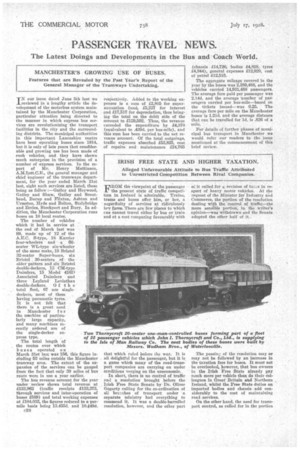PASSENGER TRAVEL NEWS.
Page 60

If you've noticed an error in this article please click here to report it so we can fix it.
The Latest Doings and Developments in the Bus and 'Coach World.
MANCHESTER'S GROWING USE OF BUSES.
Features that are Revealed by the Past Year's Report of the General Manager of the Tramways Undertaking.
IN our issue dated lune 5th last we reviewed in a lengthy article the development of the motorbus system maintained by the Manchester Corporation, particular attention being directed to the manner in which express bus services are revolutionizing the transport facilities in the city and the surrounding districts. The municipal authorities in this important Lancashire centre have been operating buses since 1914, but it is only of late years that considerable and growing use has been made of such vehicles, and they have shown much enterprise in the provision of a number of express services. In the report of Mr. Henry Mattinson, A.11.1nst.C.E., the general manager and chief engineer of the tramways department, for the year ended March 31st last, eight such services are listed, these being as follow :—Gatley and Heywood, Galley and Shaw, Galley and Scouthead, Dam and Flixton, Ashton and Urmston. Hyde and Bolton, Stalybridge and Eccles, Stockport and Bury. In addition, the Manchester Corporation runs buses on 10 local routes.
The number of vehicles which it had in service at the end of March last was 89, made up of 12 of the A.E.C. S-type, 18 Karrier four-wheelers and a 06seater WL-type six-wheeler of the same make, 15 Bristol 32-seater Super-buses, six Bristol . 30-seaters of • the older pattern and six Bristol double-deckers, 13 CM-type Daimlers, 15 Model 416D Associated Daimlers and three Leyland Leviathan double-deckers. Of th c total fleet, 67 are single
deckers, most of them having pneumatic tyres.
It is not felt that
there is a great need in Manchester for the machine of particu
larly large capacity, and many machines re cently ordered are of
the single-decker express type.
The total length of the routes over which buses operated on March 31st last was 156, this figure in eluding 53 miles outside the Manchester tramway area. The extent of the expansion of the services can be gauged from the feet that only 39 miles of bus route were in use a year earlier.
The bus revenue account for the year under review shows total revenue at 1133,962 (traffic receipts £133,373, through services and inter-operation of buses £589) and total working expenses at £104,033, the figures reduced to a permile basis being 13.4551 and 10.449d.
restieetiveiy. Added to the working expenses is a sum of £2,805 for superannuation fund, £5,237 for interest and £17,517 for depreciation, thus bringing the total on the debit side of the account to £129,592. Thus, the revenue exceeded the expenditure by 14,370 (equivalent to .4394. per bus-mile), and this sum has been carried to the net revenue account. Of the total outgoings, traffic expenses absorbed £53,825, cost a repairs and maintenance £24,765
(chassis £14,726, bodies 14,828, tyres £4,344), general expenses £12,929, cost of petrol £12,515.
The aggregate mileage covered in the year by the buses was 2,389,488, and the vehicles carried 14,931,488 passengers. The average fare paid per passenger was 2.14d. and the average number of passengers carried per, bus-mile—based on the tickets issued—was 6.25. The average fare per mile on the Manchester buses is 1.214. and the average distance that can be travelled for 1d. is .826 of a mile.
For details of further phases of municipal bus transport in Manchester we would refer our readers to the issue mentioned at the commencement of this brief review.












































































































